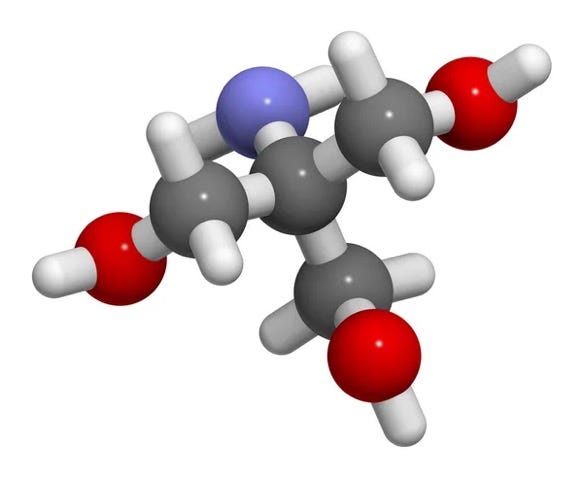Vitamin C failed in Moderna mRNA Jab preservative tests
Lipid Nanoparticle chemicals containing tertiary amine centres are easily oxidized, so Moderna published details of its experiments designed to improve stability and performance of its Covid19 jabs
I have asked before:
What would have happened if vials of Pfizer and Moderna LNP jabs hade been filled under Nitrogen or Argon.1
But that would have cost both companies more money.
Moderna has published much information about their investigations of their air-sensitive product and the patent applications reveal more rich detail of chemical disaster.2
The patent is rather long, so those interested can read the entire document, best done in html webpage, rather than the downloaded pdf because the 32 figures lose clarity.
Today, I just want to look at the various reducing agents they used to try to reduce the formation of what they casually describe as “ionizable lipid-polynucleotide adduct impurity” or Impurity Group (IG), or, in patent attorney jargon:
The term “adduct” or “adduct impurity” refers to the covalent addition of a lipid or other entity (e.g., hydrophobic entity) or polymer chain to a polynucleotide, such as mRNA. An “ionizable lipid-polynucleotide adduct impurity” (also referred to as “impurity group” or “IG”) is a type of adduct that comprises the covalent modification of a polynucleotide (e.g., in a LNP) with an ionizable lipid or a derivative thereof (such as a secondary amine or reactive aldehyde produced from decomposed ionizable lipids).
Here is a graph showing the anti-oxidants they tried as preservative at room temperature for 18 hours after mixing.
Ascorbic acid (Vitamin C), L-cysteine, BHA (Butylated hydroxyanisole, 2-tert-Butyl-4-hydroxyanisole and 3-tert-butyl-4-hydroxyanisole mixture), Methionine, Lipoic acid, Homocysteine, DDT (1,1,1-trichloro-2,2-bis-(4′-chlorophenyl)ethane), DTE (Dithioerythritol, (2R,3S)-1,4-Bis(sulfanyl)butane-2,3-diol), Cystamine, DTT (Dithiothreitol, (2S,3S)-1,4-Bis(sulfanyl)butane-2,3-diol), Glutathione, N-acetyl Cysteine, Sodium Borohydrate, Sodium Thiosulfate, TCEP (tris(2-carboxyethyl)phosphine, 3,3′,3′′-Phosphanetriyltripropanoic acid), Sodium Thioglycolate, Potassium Metabisulfite (familiar to home wine makers).
Note that a merchandiser of TWC products has completely misinterpreted this study. The vertical axis shows that as we move along the horizontal axis to more effective reducing agents, the amount of “Impurity Group” caused by oxidation decreases.
Or, quoting directly from the Moderna patent:
"Example 7. Treatment of RNA and/or Lipids with Select Anti-Oxidants and Reducing Agents Conferred Alterations to the Percentage of Impurity Group Formed
To determine if treatment with reducing agents or anti-oxidants confers reductions in the percentage of IG formed in binary mixtures of RNA and Compound III, binary mixtures were prepared with RNA and Compound III in which the RNA component was prepared with select reducing agents or anti-oxidants and the percentage of IG in the resulting binary mixtures was quantified according to the protocol detailed in Example 1. The reducing agents and anti-oxidants tested included ascorbic acid, L-cysteine, BHA, methionine, lipoic acid, homo cysteine, DDT, DTE, cystamine, DTT, glutathione, N-acetyl cysteine, sodium borohydrate, sodium thiosulfate, TCEP, and sodium thioglycolate, potassium metabisulfite, and sodium metabisulfite. In brief, reducing agent and antioxidant stock solutions were freshly prepared in water at concentrations of 0.25 M to 1 M, with the exception of lipoic acid and L-cysteine which were prepared in ethanol. For the data shown in FIG. 14 , RNA was prepared in sodium acetate pH 5.5 and aliquoted into individual vials, then spiked with each of the prepared antioxidant or reducing agent stocks to a concentration of 1.33 mM.
Addition of 4 mg/mL Compound III in ethanol to 25% of the total volume then resulted in a 1 mM final reducing agent or antioxidant concentration in each. Samples were held at 25° C. and the percentage of IG was quantified by HPLC after 18 hours (FIG. 14 )."
This particular patent repeats the fact that Moderna chose not to use Phosphate Buffered Saline (PBS) as the aqueous medium for its jabs but knew that Tromethamine (Tris)3 could scavenge the Aldehydes produced from degradation of the unstable lipid compounds.
Here is their data showing the effect of Tromethamine versus PBS.
FIG. 19 is a graph showing percentage of IG detected in LNP compositions comprising mRNA and Compound VI either in 1×PBS or in 100 mM Tris.
Moderna did a thorough study of the adduct formation with Cytidine reacting with an Aldehyde that results in stalled ribosomal expression of Spike Protein when the LNPs deliver their Endotoxin rich payload all over the body.4
FIG. 21 is a schematic diagram of how mRNA-aldehyde adduct impurity species can be detected by enzymatic digestion to nucleosides and LC-MS/MS analysis.
So there you have a few highlights that should encourage you to campaign to have the Moderna factory in Australia closed down.5
Relative Lethality of COVID-19 vaccines - who is measuring the casualties?
Japan Relative Lethality data for the Covid19 Jabs
Meredith Packer, Dipendra Gyawali, Serenus Hua, Gabor Butora, Gregory John Mercer. 22 October 2022. Lipid nanoparticle compositions and methods of formulating the same. US Patent Application US17/508,786. Granted and Published as US11524023B2. https://patents.google.com/patent/US11524023B2/en
Tromethamine is a Hazardous Substance in Jabs that Must be Banned
Tromethamine is an Endocrine Disruptor and causes Anaphylaxis.
Moderna ordered to get its Endotoxin Act together
Despite heavy redactions, including specifications and contamination limits, we learn much from reading the thousands of pages obtained by citizens in Freedom Of Information demands as well as court ordered releases.
Skerritt, Tucek-Szabo, Sutton, Nolan worry about Endotoxin and RNA Fragments in Jabs
Remember John Howard Skerritt from his days as head of the TGA?









